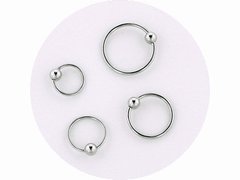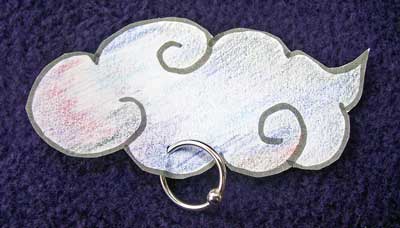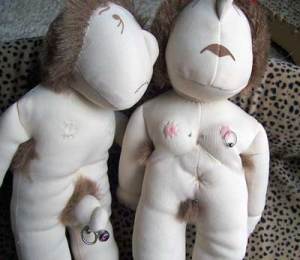
Do you have trouble wearing earrings? Do they make your earlobes sore and itchy? Have you given up? Try body jewelry!
This pretty little girl (who belongs to mhowry’s photostream at Flickr) is beaming because she just got her ears pierced. But could her jewelry be making her vulnerable to a nickel allergy, or even lead poisoning? Nickel allergies, a type of contact dermatitis, are on the rise. It can develop immediately, or over time. Jewelry worn in or against the body, especially earrings, is often cited as the cause. According to the Mayo Clinic:
Nickel allergy is commonly associated with earrings and jewelry for other body piercings. But nickel can be found in many everyday items — from coins to necklace clasps, from watchbands to eyeglass frames.
The little girl pictured above probably got her ears pierced at the mall with a gun, and will be wearing lots of cute, inexpensive earrings of the type found in every accessory store. Putting aside the problems associated with healing such a piercing with the typical crappy aftercare provided, because I’ve talked about them before, there are problems associated with the composition of the earrings themselves. Even if the piercing heals and everything seems fine, after years of wearing this type of jewelry, anyone can develop an allergy to the metal. I have talked to many women who lament not being able to wear earrings anymore, because their bodies have become sensitized to them. Dealing with the pain, redness, bumps, and blisters that can result from nickel allergies can be disheartening, to say the least. Such pierced ears can become infected, or abandoned and left to close up.
It’s all about the jewelry.
What are you putting in your ears? Most commercial earrings are made with low quality stainless steel, sterling silver, or gold filled posts or wires, all of which contain other metals as alloys. Silver and gold must be alloyed to make them hard enough to be workable, and jewelers like using nickel because it makes the findings hard and non-porous. Jewelry findings can be plated in rhodium or gold, which can flake and wear off. Gold-filled earring wires are plated, eventually wearing off to expose the base metal below. Silver is not an appropriate metal to wear in anything but well-healed, happy pierced ears, because it tarnishes. Even gold jewelry can cause problems; 14k jewelry is only 14 parts gold to 10 parts alloyed metal. Some jurisdictions have addressed jewelry quality with legislation. The European Union banned all nickel in jewelry sold there since 2000, and concerns about lead found in children’s jewelry prompted California to pass a similar law.
Be skeptical of jewelry industry claims! Even so-called “hypoallergenic jewelry” may not be. “Surgical stainless steel” is an empty term created as a marketing term by the jewelry industry. (There are various grades of stainless steel; the best stainless steel body jewelry is manufactured to contain any nickel so it doesn’t come into contact with the skin.) These are the same people who promote the use of an implement derived from cattle tagging that inflicts blunt force trauma wounds (i.e., piercing guns).

An alternative to try. On the other hand, jewelry made for body piercing enthusiasts is specifically designed for optimum healing and long-term wear in the body. Quality body jewelry in a small gauge made from implant grade stainless steel, titanium, niobium, 14k or 18k gold not containing nickel, and some high-tech plastics are excellent for wearing in lobes. Young children and people who cannot wear other types of earrings should take a look at some of the body piercing jewelry out there. Titanium is an especially good choice, because very few people react to it, it’s readily available and relatively inexpensive, and comes in un colors! Regular pierced ears are usually 20 gauge or 18 gauge, and you can buy such jewelry online without having to step foot in a tattoo or piercing studio. Take a look at some of these choices from reputable online dealers:
 Try a titanium captive bead ring from Steel Navel. These Industrial Strength CBRs are high quality, and come in plain silver colored (polish) or anodized in host of colors. They come in as small as 18 gauge, and 1/4 inch. The anodized colors will come off in time, and those little beads can be really difficult to deal with, so how about:
Try a titanium captive bead ring from Steel Navel. These Industrial Strength CBRs are high quality, and come in plain silver colored (polish) or anodized in host of colors. They come in as small as 18 gauge, and 1/4 inch. The anodized colors will come off in time, and those little beads can be really difficult to deal with, so how about:

Stainless steel fixed bead rings from Tribalectic. They come in 20 and 18 gauge and are made of high quality, implant grade stainless steel. These have a very low chance of causing allergic reactions, and you won’t lose the bead.
 For a cutting-edge alternative, you could try a Neometal titanium press-fit barbell from BodyArtForms. You can buy various ends for these little beauties, which you simply push in.
For a cutting-edge alternative, you could try a Neometal titanium press-fit barbell from BodyArtForms. You can buy various ends for these little beauties, which you simply push in.
More suggestions for happy earlobes:
This type of jewelry can be a little fiddly to get in and out (a friend with a good eye and a steady hand can help) but is meant to be worn for long periods of time. If you find something your ears are happy with, don’t change the jewelry too often. While healing, do not use alcohol, “ear-care solution,” hydrogen peroxide, Bactine, Neosporin, or anything other than a mild salt-water solution, and do not twist the jewelry. Leave the jewelry in, and wash your ears and the jewelry with mild soap and water in the shower. Dry them well. (For more information on basic aftercare, see my Body Piercing Basics page.)
Don’t be afraid of exploring the world of body jewelry for earrings you can wear if your lobes are sensitive. Take a look through some of these retailers’ catalogs for rings, barbells, and other shapes. They sell gold, titanium, and stainless steel body jewelry that’s worth a try.
Mayo Clinic Page on Nickel Allergy
State of California page on lead in jewelry ban
News article on lead in children’s jewelry
Pic of various jewelry from Ryheen’s Photostream at Flickr.
fin




 Posted by piercedconsumer
Posted by piercedconsumer 









 Try a
Try a 
 For a cutting-edge alternative, you could try a
For a cutting-edge alternative, you could try a 

 According to Salt: A World History by Mark Kurlansky (quoting Jungian pycschologist Ernest Jones):
According to Salt: A World History by Mark Kurlansky (quoting Jungian pycschologist Ernest Jones):





